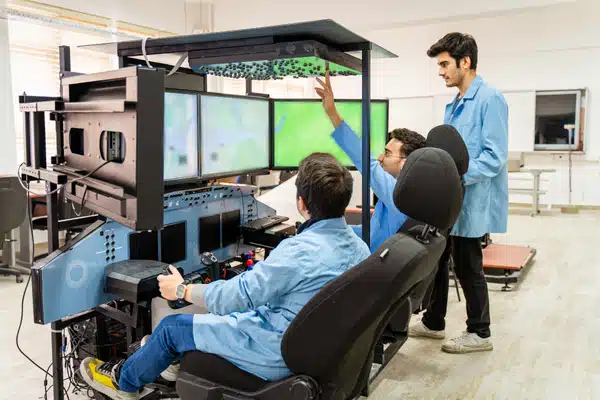Flying in darkness demands specialized skills that only proper education can provide. Night vision goggles have changed how pilots handle navigation and conduct surveillance missions after sunset. Yet these devices bring unique challenges that require focused flight training to master safely, whether in military use, hunting, or other fields that rely on advanced optics.
Modern technology now makes comprehensive NVG training possible through online platforms and advanced simulators. This approach builds real competencies in navigation while keeping costs down and safety up, especially when guided by an nvg online training center.
Why Night Vision Goggle Online Training Matters for Night Flying
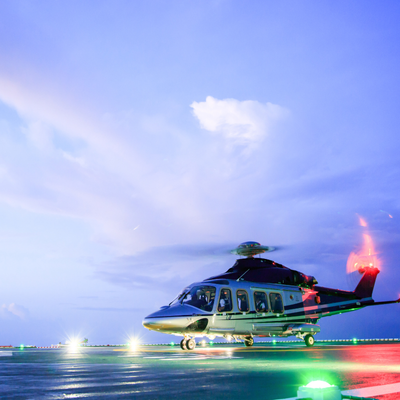
Night vision devices amplify small amounts of light to help users see in dark conditions. Military forces first used this technology, but now law enforcement, emergency services, and civilian pilots rely on it too. Hunters and wildlife researchers also benefit from these night vision systems.
However, these devices have serious limitations that make training essential. Most aviation NVG units provide only a 40-degree field of view. This narrow range reduces what pilots can see compared to normal human vision. Everything appears in green or gray tones, and bright lights can cause blooming that blocks vision.
Poor night vision goggle online training leads to accidents. Pilots without proper education often develop false confidence or become disoriented. The FAA requires specific training and currency for anyone flying with NVG equipment. These helicopter nvg training requirements exist because night vision technology demands new knowledge and habits.
Safety depends on understanding both the capabilities and limitations of your equipment. Well-designed night vision goggle online training programs address human factors and device restrictions that affect flight performance.
Key Parts of an NVG Training Program
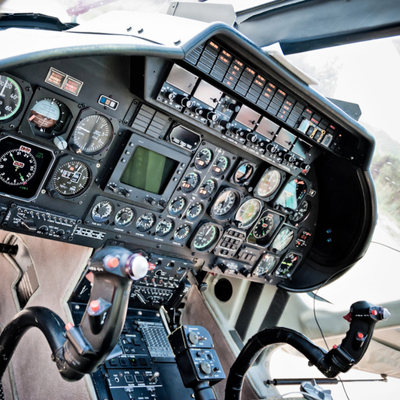
Effective nvg online training programs combine classroom learning with hands-on practice. Most courses include both ground school and practical flying exercises.
Ground school covers the theory and systems behind night vision technology. Students learn how optics and image tubes work to amplify light. The curriculum includes different equipment generations, with Gen 3 being current state-of-the-art technology.
Training procedures focus heavily on regulations and operating rules. Students study FAA requirements for aviation night vision goggle operations, including pre-flight checks and equipment standards. Human factors education covers how eyes adapt to darkness and the effects of fatigue on performance.
Environmental considerations teach students how terrain and lighting affect what they see through the goggles. Most importantly, ground school emphasizes the limitations of night vision devices. Students practice scanning techniques to make up for the narrow field of view.
Practical training moves from classroom environment to actual flying or simulator sessions. Students learn proper handling, inspection, and setup procedures before takeoff. They practice basic flight maneuvers while wearing the goggles to adjust to altered visual cues.
Navigation training helps pilots read landscapes through the green glow of NVG displays. This builds skills for staying oriented during real missions. Advanced training includes emergency operations where students handle malfunctions and urgent situations under NVG conditions.
The training syllabus also covers crew coordination. Effective communication between pilot and crew becomes vital when operating with night vision equipment. A qualified instructor guides students through each phase, sharing real-world experience and ensuring proper technique.
How Simulators Change NVG Training
Simulators have transformed how pilots learn to use night vision technology. Night vision goggle online training costs less and poses fewer risks than actual night flights. Complex scenarios that would be dangerous in real aircraft can be practiced safely in a simulator.
Modern flight simulators create incredibly realistic night scenes. Top-level systems can replicate star fields, terrain, city lights, and thermal signatures that work with real NVG goggles. Students wear actual night vision devices in the sim and see realistic night environments.
This night vision goggle training system incorporates multiple phases: theory, practical simulation, and mission rehearsal. The blended approach gives students solid understanding of both technology and practical applications. Simulator projectors output infrared wavelengths that make NVG goggles respond just like they would in real flight.
Night vision goggle online training has grown rapidly, especially since the pandemic. Night Flight Concepts developed NVIO (Night Vision Integrated Training System), which combines computer-based modules with 3D simulation. Students can access this training system 24/7 via the internet.
This training philosophy allows pilots to complete much of ground school remotely. They work through multimedia lessons and virtual demonstrations on their own schedule. By the time they arrive for hands-on helicopter nvg training, they already know the basics.
Keeping Skills Sharp Through Ongoing Education
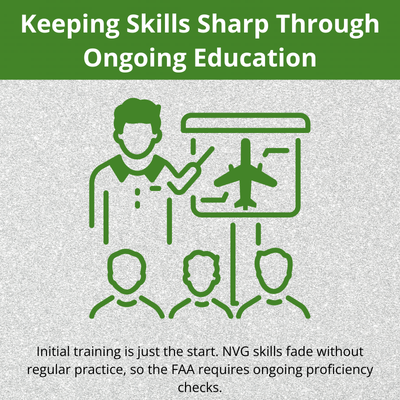
Initial night vision goggle training is just the start. NVG skills fade without regular practice, so the FAA requires ongoing proficiency checks. Within each two months, pilots must complete specific tasks like takeoffs, landings, and navigation under NVG. Without this recent experience, they must pass proficiency testing before flying with passengers.
Many operators schedule yearly refresher training to meet these training needs. These courses typically include updated ground school and night flight or simulator sessions. This keeps crews sharp and addresses any bad habits that develop over time.
A training center like ours offers both initial courses and ongoing programs to help pilots maintain certification. We also provide maintenance training since proper equipment care is critical for safe operations.
The entire night vision system includes the goggles, cockpit lighting, and support procedures. If any part fails or falls out of specification, safe NVG operations become impossible. Training both users and support staff ensures the whole system stays reliable.
Modern Training Delivers Results
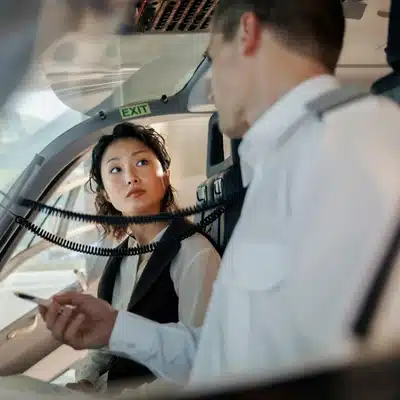
High-quality night vision goggle online training combines proven methods with new technology. Students learn theory through engaging online modules, then practice skills in safe simulator environments. This prepares them for real-world missions where mistakes can be deadly.
The training experience builds confidence while teaching respect for equipment limitations. Pilots who complete comprehensive programs can handle the mental workload of night operations. They understand when to trust their goggles and when to rely on other navigation methods.
Military, law enforcement, and civilian pilots all benefit from this structured approach. Whether the mission involves surveillance, search and rescue, or routine transport, proper training makes the difference between success and disaster.
Performance measurement shows that simulator-based programs produce highly skilled operators while reducing costs. Students can repeat difficult scenarios until they master them. They can also experience rare emergency situations that would be impossible to create safely in actual aircraft.
Frequently Asked Questions
Who should take night vision goggle online training?
NVG online training is designed for military, law enforcement, emergency services, and civilian pilots who fly at night. It is also useful for operators involved in surveillance, search and rescue, and other missions that depend on advanced optics.
What does a typical NVG online training program include?
Most courses blend computer-based ground school with simulator sessions and, when required, aircraft flights. You study NVG systems, regulations, and human factors online, then apply that knowledge in realistic night scenarios under an instructor’s guidance.
How do simulators improve NVG training compared to flying only at night?
Simulators let you practise complex and high-risk situations in complete safety, without burning fuel or exposing crew and aircraft to danger. They also allow you to repeat challenging scenarios until you build solid skills and confidence.
Is online NVG training recognised by the FAA?
Theoretical modules alone do not qualify you for NVG operations, but they can form an FAA-approved syllabus when combined with required flight or simulator events. Our training centre structures courses to align with current FAA guidance and operator requirements.
How long does it take to complete an NVG course?
Course length depends on whether you are doing initial qualification, instructor training, or a refresher. Many pilots complete the online segments over several days, then finish simulator and flight phases in a focused block of training.
Do I still need recurrent NVG training after my initial qualification?
Yes, NVG skills degrade without regular practice, so pilots must complete ongoing tasks and proficiency checks to stay current. We offer scheduled refresher programs that revisit key concepts, update you on best practices, and correct any bad habits.
Start Your NVG Training Today
Night operations don’t have to be dangerous when you have the right night vision goggle online training. Modern online and simulator-based courses make it easier than ever to develop these critical skills. Our training center combines decades of experience with the latest night vision technology to deliver superior results.
Don’t let darkness limit your mission capabilities. Contact Night Flight Concepts today to learn about our FAA-approved NVG courses. We offer initial training, instructor programs, and ongoing refresher options tailored to your objectives. Take control of the night with proper training that could save your life.

